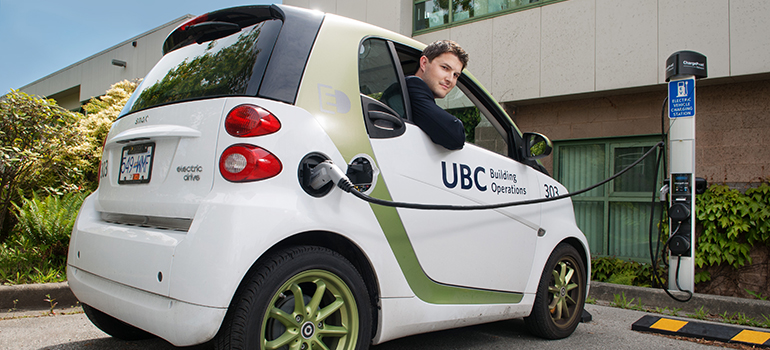New charging stations pump up UBC’s fleet of electric cars and give drivers more choices

Which came first—the widespread use of electric cars or easy access to charging stations? Like the chicken and egg question, that’s yet to be answered.
UBC is the second largest commuter destination in Metro Vancouver.
But the University of British Columbia is on its way to finding out with the debut of 18 new charging stations on campus. These will provide not only juice for electric vehicles, but fuel for sustainability research.
UBC completed its electric vehicle infrastructure project in April. Ten stations are located at the University Services Building to power its fleet of electric vehicles, which zip around on campus business. Thunderbird Parkade houses another eight stations to power electric cars driven onto campus by faculty, staff, and the general public—free of charge.
Until recently, there were no electric-car charging stations open to the public at UBC. The 16 electric vehicles that were part of the Building Services fleet had only basic facilities to charge them, as well as four wireless induction stations.
Building charging capacity
Iain Evans, the University’s associate director of strategic partnerships, explains that UBC had an operational need to upgrade these vehicles. Plus, the University wants to swap in more low-carbon vehicles to help achieve its goal of reaching zero greenhouse gas emissions by 2050. To do so, they needed a better way to fuel them.
So UBC partnered with Plug in BC, an initiative funded by the Province of BC and managed by the Fraser Basin Council. Plug in BC aims to build 570 charging stations across the province to support members of the public and organizational fleets.
“Now, with the Level 2 stations, we can charge a lot more vehicles and we can charge them faster,” says Evans.
UBC Building Operations fleet manager Adam McCluskey says that Building Operations now has 22 electric vehicles—and counting. “Rather than jumping into a big diesel vehicle, trades people can jump in an electric vehicle, where there’s no emissions whatsoever,” he says, and it costs less to run. “It’s a win-win.”
Encouraging public use
It’s also a win for students and researchers, who can use the stations as a living laboratory, and for industry, which can use them as a platform for innovation. For example, Evans explains that they could look at the demands on the network if all the vehicles plug in at once, or how electric cars might be used as emergency generators in case of a natural disaster.
“Being able to effectively network charging stations together and understand the demand on the grid is a key area for innovation,” he says. “This project provides a unique opportunity to test out things on campus that have a high societal impact that can be translated to other places in the world.”
The new stations will also encourage the public use of electric cars on campus. That’s significant because UBC is the second largest commuter destination in Metro Vancouver. “There’s an opportunity for people now to make a choice around using an electric vehicle,” says Evans.
One car-sharing company has already promised to add electric options to its campus fleet. “If students have to nip downtown, rather than grab a gasoline-powered car, they could grab an electric one,” says Evans.
Find the nearest charging station on ChargePoint.
